Stridulation is the act of producing sound by rubbing together certain body parts. This behavior is mostly associated with insects, but other animals are known to do this as well, such as a number of species of fish, snakes and spiders. The mechanism is typically that of one structure with a well-defined lip, ridge, or nodules being moved across a finely-ridged surface or vice versa, and vibrating as it does so, like the dragging of a phonograph needle across a vinyl record. Sometimes it is the structure bearing the file which resonates to produce the sound, but in other cases it is the structure bearing the scraper, with both variants possible in related groups. Common onomatopoeic words for the sounds produced by stridulation include chirp and chirrup.
The false stag beetles (Diphyllostoma) are a group of three species of rare beetles known only from California. Almost nothing is known of their life history beyond that the adults are diurnal and females are flightless; larvae have not been observed.

Quercus acutissima, the sawtooth oak, is an Asian species of oak native to China, Korea, Japan, Indochina and the Himalayas. It is widely planted in many lands and has become naturalized in parts of North America.

Dorcus is a genus of beetles in the family Lucanidae. Of the 30-odd species, most occur in Asia and India; two are found in southern Europe, and two species are from North America. Previously, specimens with serriform teeth on the mandibles and sable pigment were called Serrognathus whereas specimens with but a singular or multiple bulky notches on the mandibles and lustrous sable pigmentation were called Dorcus. Serrognathus was recently reclassified and merged into the genus Dorcus.
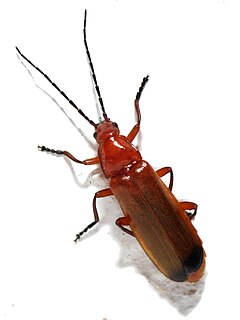
The common red soldier beetle, also misleadingly known as the bloodsucker beetle, and popularly known in England as the Hogweed Bonking Beetle is a species of soldier beetle (Cantharidae).

Lucanus cervus is the best-known species of stag beetle in Western Europe, and is the eponymous example of the genus. L. cervus is listed as Near Threatened by the IUCN Red List.

Dorcus titanus, the giant stag beetle, is a beetle of the family Lucanidae. It was described by Jean Baptiste Boisduval in 1835. In the research of Huang and Chen (2013), Serognathus has separated from Dorcus, showing the morphological and DNA analysis.
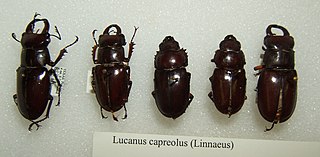
Lucanus capreolus is a beetle of the family Lucanidae. The specific name capreolus is derived from Latin, meaning "roe deer". The name refers to the resemblance of the antennae to deer antlers.

Odontolabis cuvera, the Golden Stag Beetle, is a beetle of the Family Lucanidae, stag beetles.

Phalacrognathus muelleri, colloquially the rainbow stag beetle, is a species of beetle in the family Lucanidae. It is found in northern Queensland, Australia and New Guinea.

Melyridae are a family of beetles of the superfamily Cleroidea.
The Lucanidae are a family of beetles that include the stag beetles. The family can be further subdivided in a taxonomy. The classification presented here follows Smith (2006), with the exception of the tribal classification within the Lucaninae.

Scarites is a genus of ground beetle native to the Palearctic, the Near East, North America and North Africa. There are at least 190 described species in Scarites.
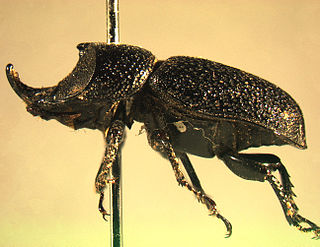
Sinodendron rugosum is a species of the family Lucanidae, the stag beetles. It is commonly referred to as the rugose stag beetle, and is the only known member of the genus Sinodendron to occur in western North America.

Cyclommatus is a genus of the Lucanidae family, also known as the stag beetle. The majority of the species from the genus Cyclommatus are located in Southeast Asia, though some species can be found in China and Taiwan as well. The genus Cyclommatus also consists of three subgenera: Cyclommatus, Cyclommatinus and Cyclommatellus. Each subgenera contains 80, 24 and 3 species respectively. In total, the genus Cyclommatus consists of a total of 134 species, though more are still being discovered to this day.
Japanese Bug Fights (世界最強虫王決定戦) refers to a more than 58-part video series featuring various kinds of insects, arachnids, and other creatures battling to the death in a little plastic arena. There are only two bugs to a fight and most fights end with one bug killing their opponent. In some cases, the fights end in a draw if neither bug is able to kill their opponent.
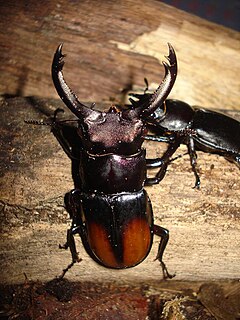
Hexarthrius parryi, the Fighting Giant Stag Beetle, is a species of large stag beetles. It belongs to the genus Hexarthrius of the tribe Lucanini. It is classified under the subfamily Lucaninae of the stag beetle family Lucanidae.

Paralissotes reticulatus, also called the New Zealand reticulate stag beetle, is a native species of stag beetle from New Zealand.
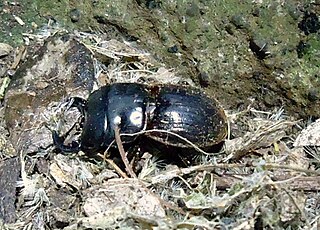
Geodorcus capito is a large flightless species of stag beetle in the family Lucanidae. It is endemic to the Chatham Islands in New Zealand.

















